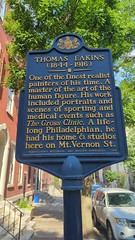Thomas Eakins
Commemorated on 4 plaques
On this site from 1884 to 1900 Thomas Eakins had his studio and painted many of his most famous pictures. Thomas Eakins lived and worked in Philadelphia almost his entire life 1844-1916
705 Walnut Street, Philadelphia, PA, United States where they had his studio (1884-1900) and painted (1884-1900)
Pennsylvania Academy of the Fine Arts. America's oldest art museum and school, founded 1805 by Peale, Rush, and other artists. Trained here were Thomas Eakins, Mary Cassatt, Maxfield Parrish, John Marin, Charles Demuth and others. Furness and Hewitt designed the Neo-Gothic building, 1876.
At the Academy, 118 N Broad St., Philadelphia, PA, United States where they trained
Thomas Eakins (1844-1916). One of the finest realist painters of his time. A master of the art of the human figure. His work included portraits and scenes of sporting and medical events such as The Gross Clinic. A lifelong Philadelphian, he had his home & studios here on Mt. Vernon St.
1729 Mt. Vernon St., Philadelphia, PA, United States where they lived and had his studio
Woodlands, The. Here, William Hamilton (1745-1813) created one of the finest landscape gardens of its day and introduced many exotic plants. His mansion and stable, built 1787-92, are early examples of the neoclassical Adamesque-Federal style. In 1840 the estate became one of the first large rural cemeteries in America. The writer S. Weir Mitchell, artist Thomas Eakins, nurse-reformer Alice Fisher, and architect Wilson Eyre are buried here.
4000 Woodland Ave., Philadelphia, PA, United States where they was buried (1916)



